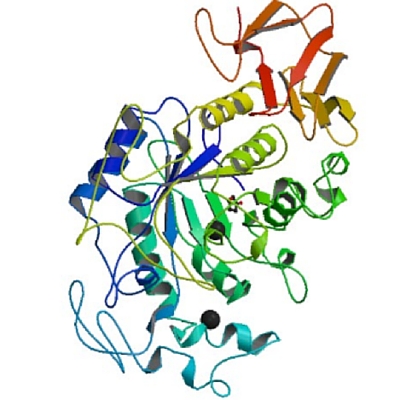
A 3D structure of Human salivary amylase.

A 3D structure of Aqualysin (protease).
Origin
Enzymes are naturally present in many living organisms such as animals, plants, bacteria and fungi. There, they participate in metabolic processes. Also, they can be found in food materials such as cereal flours, fruits and vegetables.1
Commercial Production
Commercially, enzymes are produced by fermentation. Food-grade microorganisms such as bacteria and fungi are used. They are produced as by-products of molasses or other carbon-source fermentation. Enzymes can be produced for specific activities and uses by downstream purification, conditioning and standardization.1
Function
Similar to other enzymes, ones used in bakery products can facilitate chemical reactions without undergoing any change in their molecular structure. They can be utilized continuously as long as they are not denatured. For example, heat can stop their activity. Also, there needs to be enough substrate in the flour. Examples of substrates are proteins, fats, sugars, starch or non-starch polysaccharides (cellulose, glucans, arabinoxylans).1,2
Primary uses in bakery products:3,4
- Fermentation aides
- Mix reducers
- Modifiers of dough handling properties
- Dough strengtheners
- Crumb softeners (anti-staling agents)
Types of enzymes and their function in bakery products:1,3,4
| IUPAC/IUB classification | Type | Chemical bond cleaved
Reaction catalysis/hydrolysis |
Specific function |
| Hydrolases | Protease | Protein – peptide bond |
|
| Lipase | Fats – Ester (alcohol-fatty acid) bond |
|
|
| Amylases | Starch – glycosidic bond |
|
|
| Cellulase | Cellulose – glycosidic bond |
|
|
| Xylanase / Pentosanase / Hemicellulase | Arabinoxylans – glycosidic bond | ||
| Maltase, invertase | Disaccharides, maltose and sucrose – glycosidic bond |
|
|
| Asparaginase | Proteins – amide (carbon-nitrogen) bond |
|
|
| Oxidoreductases | Glucose oxidase | Glucose – oxidation into gluconic acid and hydrogen peroxide |
|
| Hexose oxidase | Oxidation of hexose sugars (less specific) by atmospheric oxygen into gluconic acid and hydrogen peroxide | ||
| Lipoxygenase | Fatty acids – oxidation to produce peroxides |
|
|
| Transferases | Transglutaminase | Acyl-transfer reaction between carboxamide group of peptide-bound glutamine residues and a variety of primary amines | Similar functionality to glucose/hexose oxidase although using different mechanism (introduction of covalent cross-links between glutamine and lysine). |
Application
Bakery enzymes are micro ingredients usually added at levels of 0.005–0.01% (50–100 ppm based on flour weight). How much depends on the formulation and process needs. They require special conditions for optimum activity and performance:1,2
- Acidity (pH): Most bakery varieties perform well within the pH range of 4.0–7.5.
- Temperature: Chemical reaction rates double for every 18°F (10°C) increase in temperature. Optimal temperature for most commercial ones is 95–140°F/35–60°C.
- Contact time between enzyme and substrate: Enzymes need time to act on the substrate.
- Aqueous dispersion medium to support chemical reactions.
- Amount of substrate: they work better when excess of substrate is available.
- Adequate enzyme dosage
FDA regulation
Enzymes used in the bakery industry are GRAS (Generally Recognized as Safe) food additives in the US. The FDA regulates their source or origin (food-compatible) and establishes limits to their use (if applicable) based on GMP.5
References
- Mathewson, P.R. Enzymes, 2nd edition, Eagan Press Handbook Series, AACC International, Inc., 1998, pp. 1–105.
- Kuddus, M. “Introduction to Food Enzymes.” Enzymes in Food Biotechnology. Production, Applications, and Future Prospects, Academic Press, Elsevier Inc., 2019, pp. 1–18.
- Van Oort, M. “Enzymes in Bread Making.” Enzymes in Food Technology, 2nd edition, Blackwell Publishing Ltd, 2010, pp. 103–143.
- Rosell, C.M., and Dura, A. “Enzymes in Bakeries.” Enzymes in Food and Beverage Processing, CRC Press, Taylor & Francis Group, LLC, 2016, pp. 171–195.
- Smith, J. “Enzymes.” Food Additives Data Book, 2nd edition, Blackwell Publishing Ltd., 2011, pp. 366–454.
- Colakoglu, A and Özkaya, H. “Potential use of exogenous lipases for DATEM replacement to modify the rheological and thermal properties of wheat flour dough.” Journal of Cereal Science,Volume 55, Issue 3, 2012, ISSN 0733-5210. https://www.sciencedirect.com/science/article/abs/pii/S0733521012000422?fbclid=IwAR170KE53BredxMO0ENJJyJPS8TGD6k1nhcoRYvQDgnkO6jlxqfkoIkVIcE

